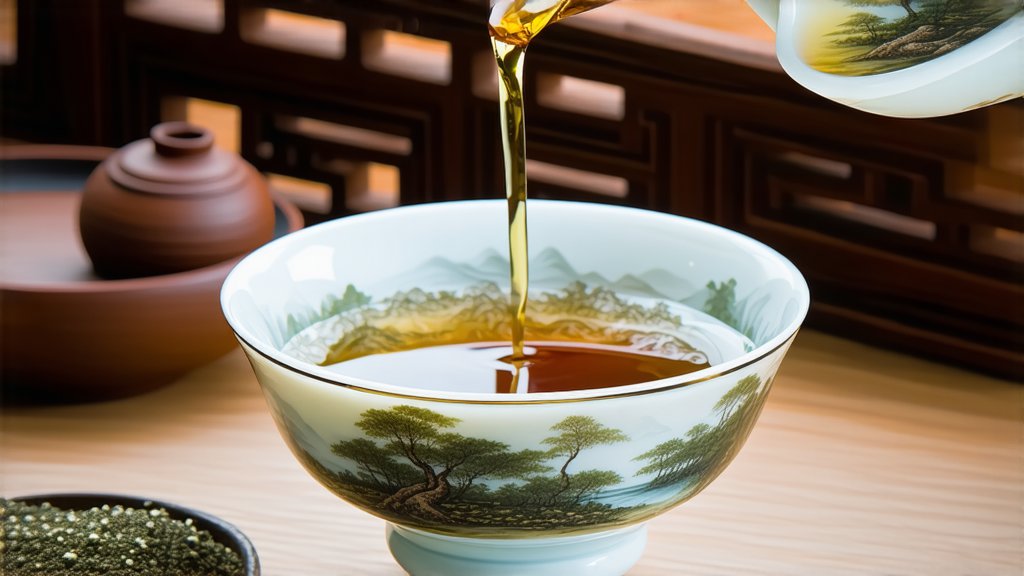
In the vast and diverse landscape of Chinese tea culture, few varieties capture the imagination and palate quite like Tieguanyin, a distinguished member of the oolong tea family. Revered for its unique flavor profile and storied history, Tieguanyin stands as a testament to China's unparalleled expertise in tea cultivation and processing. This article embarks on a journey through time and tradition to explore the origins, varieties, intricate production methods, and art of appreciating this exceptional tea.
A Historical Odyssey
The tale of Tieguanyin begins in the early 18th century during the Qing Dynasty, nestled within the lush mountains of Anxi County in Fujian Province. Legend has it that the tea was discovered by a poor scholar named Wei Yin, who stumbled upon a wild tea plant while studying for the imperial examinations. Intrigued by its distinct aroma and taste, he propagated the plant, which eventually bore his name, "Tieguanyin," meaning "Iron Goddess of Mercy." Over centuries, this tea gained immense popularity, not only across China but also internationally, earning a reputation as one of the finest teas in the world.
Varieties and Characteristics
Tieguanyin is renowned for its complex flavor profile, characterized by a harmonious blend of floral notes, creamy texture, and a hint of sweetness. There are primarily two types of Tieguanyin based on their processing methods: traditional and modern. Traditional Tieguanyin undergoes a more labor-intensive process involving withering, shaking (to bruise the leaves slightly), fixation, rolling, oxidation, roasting, and drying, which results in a more pronounced orchid fragrance and a richer taste. Conversely, modern Tieguanyin employs a lighter oxidation process, yielding a fresher, greener character with subtler floral undertones.
The Art of Craftsmanship
The creation of Tieguanyin is an art form that demands meticulous attention to detail. Harvested from the tender shoots and leaves of the Camellia sinensis plant, the journey from leaf to cup involves several stages:
-
Withering: Freshly picked leaves are spread out under the sun or in shaded areas to reduce moisture content, softening them for subsequent steps.
-
Shaking (Bruising): Leaves are gently tossed or shaken to further bruise the edges, facilitating enzymatic reactions that contribute to the tea's distinctive aroma.
-
Fixation: By briefly heating the leaves in a hot wok or steaming them, enzyme activity is halted, preserving the desired level of oxidation.
-
Rolling: Leaves are rolled to form tight pellets, enhancing extraction during brewing.
-
Oxidation: Depending on the desired style, leaves may be left to oxidize partially (modern) or fully (traditional) before final shaping.
-
Roasting: This step imparts depth and complexity to the flavor, balancing any residual moisture.
-
Drying: Final drying ensures stability and longevity of the tea.
The Ritual of Appreciation
To truly appreciate Tieguanyin, one must engage in the traditional Chinese tea ceremony, known as Gongfu Cha. This elaborate ritual emphasizes mindfulness, respect for the tea, and the art of preparation. Here's a brief outline of the Gongfu Cha method for enjoying Tieguanyin:
-
Warm the Teapot: Rinse the teapot and cups with hot water to elevate the temperature and cleanse any impurities.
-
Tea Measurement: Use approximately 5 grams of Tieguanyin per 150ml of water. Place the leaves into a gaiwan (lidded bowl) or Yixing clay teapot for optimal flavor extraction.
-
Initial Rinse: Briefly rinse the tea leaves with hot water (around 95°C) to awaken them, then discard this first infusion.
-
Steeping: Steep the tea for about 15-30 seconds for subsequent infusions, gradually increasing steeping time as the leaves unfurl.
-
Pouring and Smelling: Pour the brewed tea into small cups, taking a moment to appreciate the aroma before tasting.
-
Sipping: Savor each sip, allowing the tea to coat your palate and revealing its multifaceted flavors.
Conclusion
Tieguanyin embodies the essence of Chinese tea culture – a blend of history, artistry, and sensory delight. Its journey from a humble wild plant to a globally acclaimed beverage speaks volumes about the dedication and skill of Chinese tea masters throughout generations. As we raise our cups to this iron goddess, her legacy continues to inspire tea enthusiasts worldwide, inviting them to partake in a timeless tradition of tranquility and reflection.